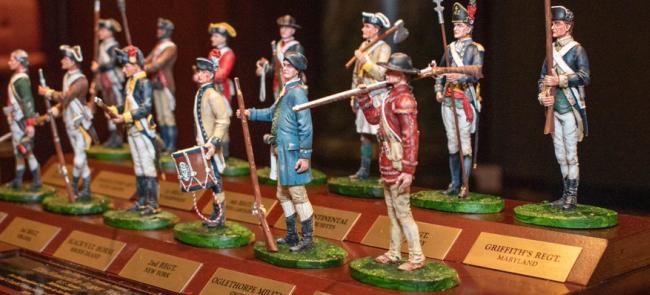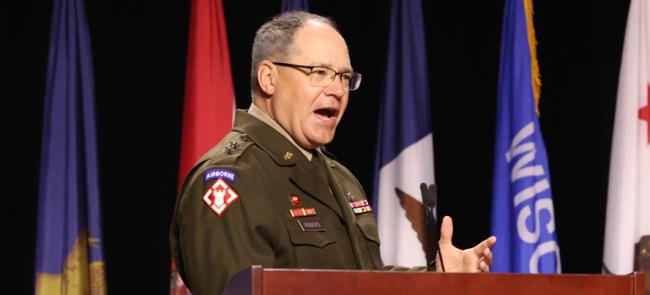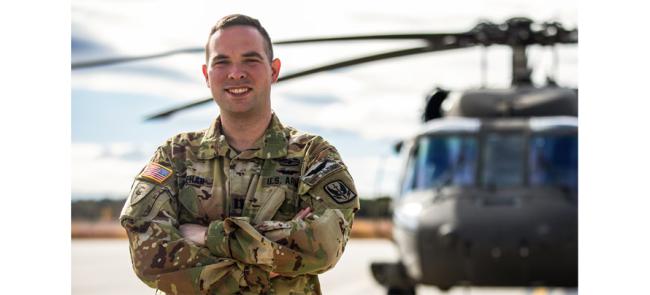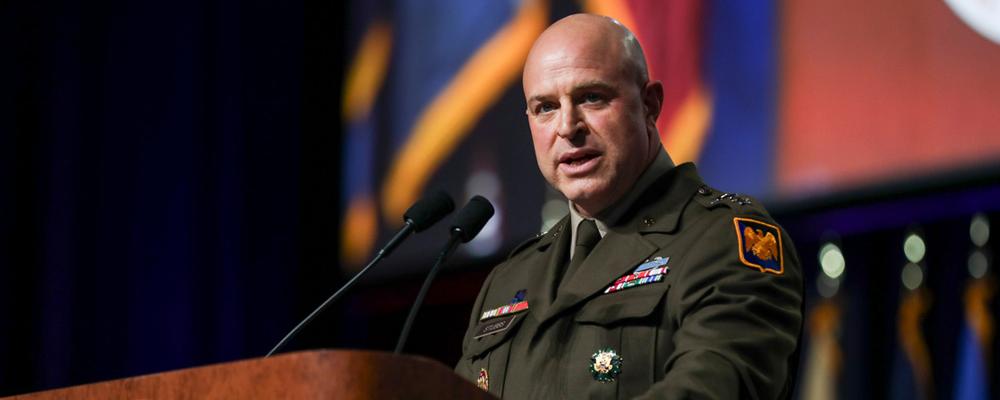
A Conversation with Lt. Gen. Jonathan Stubbs
Lt. Gen. Jonathan Stubbs still follows some advice he received early in his career from a trusted mentor: “Be in the moment.”
In other words, don’t wish away the challenges. They’ll make you a better officer.
Stubbs says he relied on that wisdom to navigate the unique challenges he faced in his first few weeks last year at the National Guard Bureau.
The former Adjutant General of Arkansas, a federally recognized one-star general at the time, arrived to be the Army National Guard director only to find himself suddenly and unexpectedly in the role of acting NGB chief and a member of the Joint Chiefs of Staff.
Now settled in as Army Guard director, he has another big challenge in front of him — the Army Transformation Initiative, which aims to make the service a leaner, more lethal force. The plan is more revolutionary than evolutionary. And Army leaders want to see significant results by 2027.
Stubbs sat down recently with NATIONAL GUARD in his office at the Herbert R. Temple Jr. Army National Guard Readiness Center in Arlington, Virginia, to talk about his year on the job and the way forward for the Army Guard.
I want to start by going back to your first days at the National Guard Bureau. It had to be a whirlwind. You were a federally recognized one-star general on Aug. 1 when the Senate confirmed you as director of the Army National Guard. Two days later, you were sworn in and promoted to three-stars. But, due to retirements at the Guard Bureau, you suddenly had another job. You were the acting NGB chief. What was that like? Any lessons learned?
It was a little disorienting because, as you described, it happened so quickly, and I had no warning. I went from being a federally recognized one-star, but an adjutant general nonetheless, to a confirmed two-star general. Then, the next day to a confirmed three-star general. Then, the next week, I found myself as the acting chief of the National Guard Bureau.
But I fell back on my military training. I also understood the value of a great staff, and there is a great staff there at the Office of the Chief of the National Guard Bureau that really helped me navigate that transition from adjutant general to acting chief.
One of the lessons I learned is you must be ready. You never know what’s going to happen. So, regardless of where you are in your career, you need to be ready for the next thing. You need to be ready to immediately assume responsibilities that are maybe higher than your current pay grade, because you just never know what’s going to happen.
You’ve had the chance to visit with Army National Guard Soldiers and units across the country and around the world since you took over as director. What are they telling you about the force and its utilization?
I’ve been around the world to visit our Soldiers — Germany, Guam, Hawaii and throughout the Continental United States. What they’re telling me is, they’re proud of what they do, proud of who they are and the organization they belong to. They’re proud to be Guardsmen.
I think they’re eager. They’re eager about this period of transformation that we’re going through. It’s amazing how adaptive our Soldiers are, how professional our Soldiers are, how creative our Soldiers are with respect to overcoming adversity. I mean, whether it’s with resources or whether it’s in the conditions that they find themselves in, they just innovate, they adapt, they overcome and they accomplish the mission.
Recruiting is up across the Army, including the Army National Guard. Do you have some numbers to share? To what do you attribute the upswing after a few challenging years?
Right now, we are up to over 327,700 Soldiers in the Army National Guard. Where Congress wanted us to land was 325,000. That was what was codified in the fiscal 2025 National Defense Authorization Act. So, we’re well above where we should be, and we’re about 4,000 ahead of where we were this time last year in terms of recruiting this fiscal year to date.
So, our recruiting enterprise is in a very strong position right now. Again, we’re outperforming last year, certainly outperforming the year before that and the year before that. Year over year, we are demonstrating a remarkable improvement in our recruiting and our retention. We’re at about 108% of our recruiting mission year to date and we’re about 110% of our retention mission.
I’m very proud of the retention mission, because it tells me as the Director of the Army National Guard is that the Soldiers we recruit are, by in large, satisfied with their service. They want to remain in the Army National Guard.
The Army Transformation Initiative is the big news these days. Army leaders said in a May 1 letter to the force that the service would be transforming to “a leaner, more lethal force.” Were you involved in the development of ATI?
I had input. Certainly, I had had an opportunity to dialog and iterate with Army senior leaders. The Chief of Staff of the Army has been laser focused on leading the Army as an enterprise since assuming his post. Gen. [Randy A.] George extended a number of opportunities to hear what we had to say. They value the Army National Guard. They value what we do as part of the Total Army. And they brought our perspective into those discussions.
What’s driving ATI? Is it purely changes in the character of war driven by advancing technology?
I think that’s a big part of it. And evaluating ourselves, we’re probably overstructured as an army. We need to be leaner. We also need to be a more agile, adaptive, lethal and affordable force for the nation.
I believe we’re also at a strategic inflection point right now as it relates to the global security environment, the priority of theater shifting to the Indo Pacific. There are some realities there as it relates to the application of land power, and I think that it really drove the Army to make some of these decisions to orient not just to the Pacific but the emerging and proliferating character of war that is turning towards rapid technological advancement, ubiquitous sensing and unmanned aerial systems. The Army just needed to change and to move in that direction.
You deployed to Iraq twice as a member of the 39th Infantry Brigade Combat Team during the height of operations there, once as company commander and the other time as the brigade S3. How much in your opinion has the character of war changed in the last decade or so?
It’s remarkable. You think how much has changed over the last three years just with respect to the war in Ukraine. The war in Ukraine really kicked off a proliferation of unmanned aerial systems at scale in terms of drone technology. What it has done in terms of exponential growth and application on the battlefield is mind boggling — individually launched UAS or drone systems at scale and orders of magnitude and tens and thousands that are operating over Ukraine right now. There are one-way attack drones, first-person viewer; I mean, you name it. What has happened over the last three years has really shaped the future and the way we’re going to fight wars of the future, hence the need for us to change the way that we’re organized and the platforms that we employ in large-scale combat operations.
We need to be leaner. We also need to be a more agile, adaptive, lethal and affordable force.
A key part of continuous transformation is the accelerated development of the mobile brigade combat team concept. How does an MBCT differ from the existing brigade combat teams?
The mobile infantry brigade is going to be a little bit smaller than the traditional legacy infantry brigade combat team. The infantry brigade combat team is around a 4,200-Soldier organization. I think, when it’s all said and done, a mobile infantry brigade is going to land somewhere around 1,900 to 2,000 Soldiers. And then you add in a light support battalion of about 500, 550 Soldiers. It’ll put you in the 2,500 range in terms of a unit and a capability.
So, it’s going to get a little bit smaller. But at the same time, it’s going to be more agile, more adaptive. It’s going to be a modernized organization. It’s going to be an organization that’s enabled by next-generation command and control by more drone or UAS technology at every echelon — squad, platoon, company, battalion levels. And then it’s also going to be equipped with next-generation weapons and then a new platform. The Infantry Squad Vehicle is going to be at the hub in terms of its mobility, moving forward.
Reports indicate the Army National Guard will be converting at least three armored brigades and two Stryker brigades to MBCTs. As you mentioned, the key ground vehicle for an MBCT is the Infantry Squad Vehicle, which is a stripped-down Chevy Colorado pickup. It’s lighter and much more agile than an Abrams tank or Stryker vehicle. It’s certainly easier to deploy, but aren’t these units losing a lot of firepower?
There’s a quality of lethality associated with being more maneuverable, more agile, more adaptive. And it’s not just lethality, but survivability. We see reflections coming out of Ukraine and some of the challenges that heavier formations are encountering up near the forward edge of the battle area because of all the ubiquitous sensing one-way attacks, precision fires and everything else that resides there.
The armor formations and the Stryker formations that we are transforming are going to have more capabilities and be more mobile. And the mobility will allow them to be more agile, which will allow them to be more survivable and, in turn, to be more lethal to apply the firepower that’s going to be resident within the formations.
ATI has an ambitious timeline. What do you see as the biggest challenges in meeting it?
The biggest challenge is just making sure that we train our Soldiers, especially those in the armor and Stryker brigades transitioning to mobile infantry formations, making sure that we do all that we can do to make sure that they’re adequately trained. The schools’ enterprise is going to be critical to us moving forward, so we do all the MOS [Military Occupational Specialty] conversion for our folks. And then there’s just the practical aspects of moving equipment around and cross-leveling equipment and making sure that we get the equipment in the hands of the Soldiers at the right time, at the right place, so they can train and build readiness.
What advice do you have for commanders and platoon leaders in armored brigades as they convert to MBCTs? These brigades have had tanks for decades, and Soldiers in tank units love their tanks.
What I would say is, this is our time. And as I mentioned at the outset, we are at an inflection point with respect to the geo-strategic environment, the changing character of war and everything else. So, we must change. We’ve done this before. Guardsmen were on horseback prior to the mechanization of war. As we entered World War I, we came off our horses because they were proven mostly ineffective due to the mechanization of war and the machine gun.
It’s just a matter of keeping pace with the changing character of war. So, I would ask leaders within our armor and Stryker formations to embrace the change to go all-in on the change. And with this change, there is great opportunity for us. There is great opportunity in terms of us being in relevant formations for the future fight, whether it’s in the Indo Pacific or elsewhere. There is great opportunity for us to continue to demonstrate the value proposition of the Army National Guard as the combat reserve of the Army, understanding that we’re 42% of the Army’s combat power.
We’ll retain our eight combat divisions and our 27 brigade combat teams. We’ll still make up over 50% of the Army’s artillery. Those core things about us, with respect to us being the combat reserve of the Army, are not going to change.
You mentioned artillery. As you said, the Army National Guard provides more than half of the Army’s field artillery. What’s in store for Army National Guard field artillery formations?
We’re looking into what’s next, and we know that longer-range fires are required. Whether that’s provided through next-generation cannon artillery systems, what’s typically been known as the extended-range cannon artillery platform or rocket artillery. However it evolves, the Guard is going to be in that business.
We’re seeing the Ukrainian army use our HIMARS [High Mobility Artillery Rocket System] and our MLRS [Multiple Launch Rocket System] to great effect. And we understand that rocket artillery is going to be key and critical, because it can reach out so far in terms of the battlefield. And then we talk about the changing character of war, and we see things kind of flipped on its head. It used to be, and we grew up with indirect fires enabling maneuver. Now, we’re seeing maneuver enabling fires on the modern battlefield, and that’s coming out of Ukraine.
So, I think the future is bright for our field artillery organizations, and we’re looking to, over time, learn lessons, transform them to make them as capable and lethal in supporting large-scale combat operations.
Army leaders in ATI information campaigns have characterized Humvees as obsolete. The Army National Guard has more than 40,000 of them. A Humvee’s versatility has been critical to domestic response. They would also appear to offer more protection from the elements than the Infantry Squad Vehicle. What will happen to them?
The Army Guard is going to hang on to Humvees. What the ATI announcement stated was no new procurement. But the Humvee is going to remain a critical piece of rolling stock for the Army National Guard well into the future. So, that vehicle, that platform, will be maintained within our Guard formations for the foreseeable future.
It's just a matter of keeping pace with the changing character of war.
A current topic of discussion is closing the “counter-UAS capability gap.” The talk preceded the announcement of ATI. What do Army National Guard combat leaders need to know and do about this capability gap?
Unmanned aerial systems are going to be critical and decisive for our leaders moving forward, as they look to apply lethal effects onto the enemy. Unless you can see and sense, you cannot effectively shoot or protect, so the ability for our leaders to leverage, to be able to understand how to leverage unmanned aerial technology is going to be decisive.
I can’t overstress enough this whole notion of seeing, sensing and shooting or seeing, sensing and protecting a formation. It’s going to be critical to our future success on the battlefield. I think we’ve got to learn lessons. We’ve got to pay attention to what’s going on overseas. We’ve got to be innovative in how we integrate unmanned aerial systems into our own training. And, again, we need to move out.
We’ve got states and we’ve got units that are innovating on their own, and we continue to champion that as we wait on fielding solutions for unmanned aerial systems that are bought and fielded by the Army. We will also have opportunities through the [congressionally directed] National Guard and Reserve Equipment Account to buy interim solutions that get those systems in the hands of our Soldiers so they can experiment and innovate themselves.
The Army National Guard has a lot of old UH-60 Black Hawk helicopters. Hundreds were set to be replaced by a program that was supposed to upgrade Lima-model Black Hawks. But the Army cancelled the so-called Victor program last year. Now, the Army wants to accelerate the fielding of the Future Long-Range Assault Aircraft, the MV-75 tiltrotor. Where do things stand with Black Hawk modernization?
Black Hawk helicopters are central to Army Guard aviation. I’ll use the word decisive. They’re decisive here in the homeland, most certainly as we look to respond to the needs of our governors following disasters. We saw that play out last year following a series of hurricanes across the Southeast. And they’re also going to continue to be decisive to the war fight.
Right now, we have about 390 UH-60Ls in the Army Guard inventory, and we are going to continue to pursue Black Hawk modernization. Whether it’s through additional procurement of UH-60M models or it’s modernizing our UH-60Ls to the highest standard that we can get them in the interim, that’s what we’re looking to do.
You’ve probably had a lot of mentors over the course of your career. What is the best leadership advice you’ve ever received? And do you still apply it to your day-to-day activities?
It’s something that I impart on junior leaders. I tell them to be in the moment. It’s hard when you find yourself in a challenging situation, maybe like I did as the interim or the acting chief of the National Guard Bureau. Or you find yourself in a challenging operational environment. You can easily find yourself looking past the experience: I can’t wait to get out of this and to the next thing.
Or maybe you’re a lieutenant, and you say, “I can’t wait to be a captain.” Or you’re a captain and you can’t wait to be a major. What I tell people is, just be in the moment, because the moment has a lot to teach us and to show us. And by investing yourself in the moment where you are, no matter where you are, it’s just going to make you that much better of an officer as you progress in grade and progress in responsibility.
So, don’t wish away the challenges. Don’t wish away the challenging moments. Don’t wish away your junior years in grade, whether you’re a noncommissioned officer or an officer. Be in the moment and invest yourselves in the mission and invest yourself in your Soldiers.
TOP PHOTO: Sgt. 1st Class Zach Sheely | BOTTOM PHOTO: Sgt. 1st Class Daisy Broker
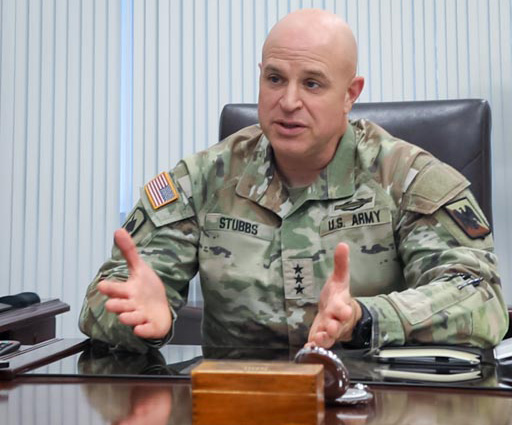
AT A GLANCE: Lt. Gen. Jonathan Stubbs
BORN: Jonathan M. Stubbs, April 8, 1972 (Memphis, Tennessee)
FAMILY: Wife (Jane), two children
EDUCATION: Lambuth University, Jackson, Tenn, B.S. Political Science; U.S. Army War College, Carlisle, Pa., M.A. Strategic Studies
COMMISSIONING SOURCE: Officer Candidate School (Tennessee Military Academy}
MILITARY SERVICE: Tennessee Army National Guard, 1993-1995; Arkansas Army National Guard, 1995-present
PREVIOUS ASSIGNMENTS: Acting Chief, National Guard Bureau, Arlington, Va., 2024; Adjutant General of Arkansas, North Little Rock, Ark., 2023-2024; Deputy Director of Operations, Readiness and Mobilization, Department of the Army, Washington, D.C., 2022-2023; Vice Director, Operations Directorate, National Guard Bureau, J-3/4/7, Arlington, Va., 2021-2022 ; Brigade Commander, 39th Infantry Brigade Combat Team, North Little Rock, Ark., 2019-2021
OVERSEAS OPERATIONS: Iraqi Freedom (January-December 2008 & April 2004-March 2005)
ALSO NOTABLE: Began military career as a private first class before attending OCS in 1995. Held every leadership position in the 39th Infantry Brigade Combat Team, from rifle platoon leader to brigade commander. Served as an Active Guard Reserve from 1997 to 2021. His culminating AGR staff assignment was as the chief of staff of the Arkansas Army National Guard.
Source: National Guard Bureau

